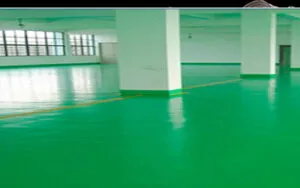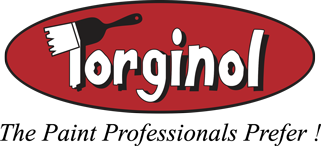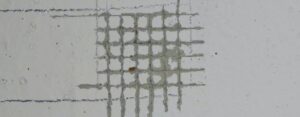HOW TO PREPARE CONCRETE FLOOR BEFORE PAINTING
Before painting a concrete floor, the floor should be tested to see what preparation is needed to assure the coating will adhere well.
Materials required:
- Cleaning supplies
- Muriatic acid
- Baking Soda
- Water
Test for the presence of a curing compound. Most concrete floors had a chemical curing agent applied after the concrete has been set. Many of these curing agents will prevent good adhesion of coatings. To test for a curing agent, pour a small amount muriatic acid on the floor. If the solution bubbles, there isn’t any curing compound left on the surface or there wasn’t one to begin with. If the acid doesn’t bubble, then there is a curing compound on the surface that must be removed before painting. Check several different areas of the floor because the curing compounds may have worn off unevenly.
Removing curing compounds.
Curing compounds must be removed with either chemical removers or mechanically by floor machines equipped with screeds or shot blasting.
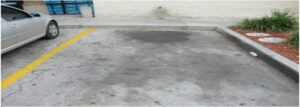
Test for grease and oil: coatings will not adhere to grease and oil. Unfortunately, grease and oils are commonly found on concrete floors. Dark spots are an indicator that grease and oil are on the floor.
Sprinkle a small amount water on the floor. If it beads up, grease and/or oil may be present. Note that a curing agent may also bead up water. Another test is to apply a piece of duct tape to the area in question. If the tape pulls away very easily, grease and/or oil are present. Grease and oil must be removed before coating.
Apply a good commercial oil and grease remover and follow the manufacturers recommendations. Use an electric floor scrubber or a stiff bristle brush. Alternatively, use a strong TSP solution and floor scrubber or bristle brush. Rinse well and allow to dry. The floor color should be relatively uniform. If there are dark spots, put a small amount of muriatic acid on the spots. If the acid bubbles, the floor is ok to coat. If the acid doesn’t bubble, grease and/or oil are still present and the floor must be degreased again. Repeat these steps until the floor is completely free of grease and oil.
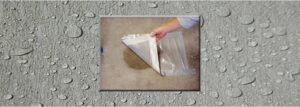
Testing for Moisture
If the concrete is wet, the coating will not adhere properly.
If the water is coming from underneath the slab, hydrostatic pressure may cause the coating to lift off. To test for moisture, tape a 2 foot square piece of plastic on all four sides to the floor. Let rest overnight. Inspect the inside of the plastic for water drops. If water is present, the concrete is too wet to paint. Repeat the test after a week or two. If moisture is still indicated, water may be coming up from underneath the concrete slab. If so, the source of the water must be found and the water diverted or coating failure is likely to occur.
Testing for Adhesion of Existing Coatings
Existing coatings do not necessarily have to be removed. It may be possible to coat right over them if they are in good condition and are adhering well to the concrete. To test adhesion, score the existing coating down to the concrete with a sharp knife. Make five cuts about two inches in length parallel to another about _” apart. Make five more cuts at 90 degrees to the first so you end up with 50 little _ inch squares. Apply duct tape to the area and firmly press it in place. Pull off the tape. If the coating doesn’t pull up the squares, the coating is ok to leave in place. If a significant number of squares come up, the coating needs to be removed. It is normal to get a little dry paint on the tape where the cuts were made.
REMOVING OLD PAINT:
Before repainting, first we should remove the old peeling and flaking paint to provide a solid base for the new layer of paint.
Removing paint from the concrete surface with the help of chemicals is very harmful. It is not safe to use chemicals and harmful liquids to remove the paint from the surface, especially if you have small children’s and pets in your home. Hence chemical cleaning should be used as a last reserve or where other techniques are not feasible.
Though there are many cleaning methods available like, sanding, grinding, blasting etc., pressure washing is the economical and most used technique.
In the pressure washer method, the substrate is washed with water with high-pressure intensity resulting in the removal of loosely bonded paints.
If the paint is not removed with the pressure washer, then the use of Chemicals method like Rip-off Paint Remover can be used.
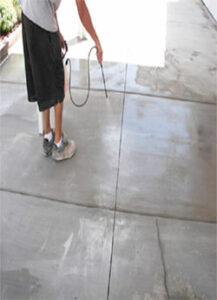
Chemical removers can also be used by following the manufacturers instructions.
Acid Etching
All concrete surfaces should be etched before painting with a solution of one part muriatic acid and three parts water. (Wear rubber gloves and goggles because this solution is hazardous.) Allow solution to bubble, when the bubbling action of the acid solution slows down, spray the area with a generous amount of water or first spray a solution of one pound of baking soda in five gallons of water to neutralize the acid and then flush with water. Brush while rinsing to remove all loose concrete.
Allow surface to dry completely. A properly etched surface should be clean and have the texture of medium grit sandpaper which would allow immediate water penetration and ensure the material being applied will bond to the concrete substrate, if not, the acid etching process must be repeated. Additional vacuuming may be required to remove powdery residue left from etching.
